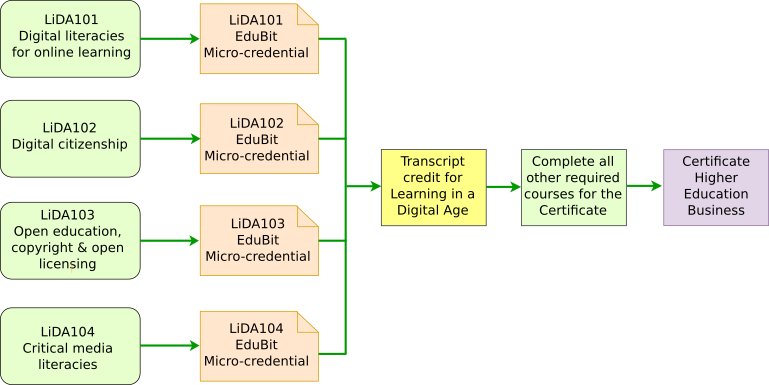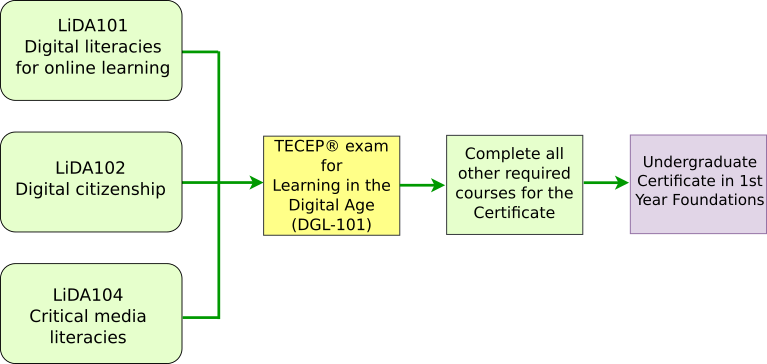Learning in a digital age/LiDA101 protections/Lida101 end matter
Overview of options for certification
- What certification and qualification options are available?
- How do I certify my participation in this micro-course?
Stackable micro-credentials
Stackable micro-credentials validate your skills and 'show what you know'. Each micro-credential assessment is small enough to be manageable for busy people, but big enough to be meaningful to employers. They also offer pathways to achieve academic credit towards selected qualifications.
Qualification options for formal credit
Each approved qualification has different assessment requirements determined by the conferring institution. If you successfully complete the prescribed assessments, you will be eligible for academic credit towards the recognised Certificate qualification at the first year, undergraduate degree level. These certificates provide pathways to transfer into a Bachelor’s degree at the respective institutions.
Click on the qualification you are aiming for, for details on the steps for achieving academic credit.
| Qualification | Conferring institution |
|---|---|
| Certificate of Higher Education Business (OERu) | The University of the Highlands and Islands United Kingdom |
| Undergraduate Certificate in First Year Foundations | Thomas Edison State University United States |
Some of you may be studying this micro-course for personal interest, in which case there is no requirement for taking any sort of test or exam. However, if you wish to be assessed or to demonstrate your learning to others, we offer a number of options for certification or formal academic credit towards qualifications. It is up to you to decide which option best suits your needs and situation.
Certificate of participation
Each micro-course has an online knowledge test built into it. The test is made up of 30 to 40 true/false and multiple choice questions, covering the materials included in the micro-course. The test has a 50% pass mark and is marked automatically.
The test is designed to demonstrate engagement in the micro-course; it will be hard to pass without having read and reflected on the course materials.
A certificate of participation could be useful, for example, to give evidence to a potential or current employer of:
- your commitment to expanding your knowledge in this area, and
- a basic level of knowledge of the topic.
Please note: the test is not designed to assess achievement at the standard required for a university course, and a certificate of participation will not be recognised by higher education institutions or employers as an academic qualification.
If you pass the knowledge test, OERu will provide you with evidence in the form of an electronic badge (no charge) or a certificate combined with an electronic badge (NZ$10 contribution to cover administrative costs).
For more information on this option, read the certify participation page.
EduBit micro-credential
This micro-course is also associated with an EduBit for Digital literacies for online learning (LiDA101). An EduBit is a micro-credential offered by Otago Polytechnic with pathways to achieve formal academic credit towards selected qualifications from OERu partners.
The assessment associated with an EduBit requires additional original work and reflection on the learning materials. About 15-20 hours of work is likely to be needed to complete the EduBit assessment successfully, in addition to working through the course materials. On payment of the prescribed fee, the assessment is marked by an assessor to determine if you have met the learning outcomes approved by Otago Polytechnic.
For more information on this option, see:
- Stackable micro-credentials
- Assessment tasks
- Assessment rubric
- EduBit submission (You must have an account on the EduBits website to submit).
Academic credit
If you successfully complete the required number of Learning in a Digital Age micro-courses, and corresponding assessments, you will be eligible for academic credit which can contribute towards you achieving a recognised Certificate qualification at the first year, undergraduate degree level. (Note that there may be an administrative fee payable to the relevant institution for issuing a transcript for your credit.)
For more information on the assessments and pathways for credit recognition for Digital literacies for online learning (LiDA101), click on the qualification options below:
- A personalized LiDA101 Certificate of Participation in PDF format that you can print out, together with a verification code for employers. This option also includes a digital badge. (Cost is NZ$10), or
- A digital LiDA101 Participant Badge (Free)
How does it work?
To certify your participation in this micro-course, you must successfully complete a basic knowledge test online. This knowledge test covers selected concepts in this course. Learners who have worked through the course resources, activities, and quizzes on the course site will have all the learning materials they need to be able to pass the test.
The online test is hosted on our moodle.oeru.org website (see links below).
Can I prepare for the test?
Yes! At the end of each learning pathway, you will find several True-False and Multiple Choice questions, together with feedback on correct and incorrect answers. These are the same questions that are used in the knowledge test to certify your participation. You can review the knowledge test questions for each learning pathway by visiting the following links:
- Establish a personal learning environment
- Introduction to digital literacies
- Find and select open resources
- Learning in a digital age
Can I trial the technology before I take the knowledge test?
Yes! If you have not taken an online test before, or have not used the Moodle platform, we have created a practice test for you to familiarise yourself with the online test environment. Try it!
- Log in to our Moodle site, How to take an online test:
- If you are a new user and don't have an account, click on the "Create new account" button on the bottom of the page. Follow the instructions to verify your account in the email we send (check your spam folder if you don't receive this email.)
- For existing OERu Moodle users, log in with your username and password for this site. (You can retrieve log-in credentials by clicking on the "Forgotten your username or password?" link.)
- Click on the course: How to take an online test, and follow the instructions on screen.
What can I expect in the test?
The following table summarizes the basic information of a typical OERu knowledge test to certify participation:
| Aspect | Number |
|---|---|
| Number of True-False questions | 16 - 20 |
| Number of Multiple Choice questions | 16 - 20 |
| Estimated time required | 20 - 30 minutes |
| Pass mark to earn the certification | Minimum of 50% of answers correct |
What are the certification options?
There are two options to certify your participation:
| Option | Cost |
|---|---|
| PDF Certificate plus digital badge | NZ$10 |
| Digital badge only | Free |
Certificate of participation plus digital badge
| Item | Details |
|---|---|
| Cost: | 10 New Zealand Dollars (Approximate cost in: US$, GBP and EUR) |
| Payment options: | Credit card only |
| Test link: | https://moodle.oeru.org/course/view.php?id=6 |
| Example: | Preview example certificate (1.1MB) |
| Number of test attempts: | Unlimited |
On successful completion of the knowledge test, we will send you an email with the PDF version of the Certificate of participation for this micro-course as an attachment.
As a charitable organization, the OERu offers unrestricted access to all our open online courses for free. By choosing to purchase a Certificate of Participation, your payment will help to cover the costs of administration and also contribute to the global technology infrastructure costs to continue providing free access to learning opportunities for all.
Digital participant badge
| Item | Details |
|---|---|
| Cost | Free |
| Number of test attempts | Maximum of two free attempts* |
| Test link: | https://moodle.oeru.org/course/view.php?id=11 |
*At OERu, we want you to succeed. Although you can only have two attempts at the test on the Moodle site if you are trying for a free badge, you can still practise as many times as you like by using the quizzes at the end of each learning pathway of the relevant micro-course.
What can I do with a certificate of participation?
You can:
- download a copy of your certificate from our site at any time,
- print a copy of the certificate for display or inclusion in your CV, and
- share the unique code printed on the certificate with employers (and other interested persons) to verify that your certificate was issued by the OERu, using the verification link.
What can I do with a digital badge?
You can:
- display OERu badges that you earn on your profile page on our moodle.oeru.org site,
- download a copy of the badge, and
- share a unique link with employers and other interested people, to verify that the badge was issued by the OERu site. This unique link provides access to a webpage that publishes the details of the issuer and criteria used to issue the badge.
Please note: If you are planning to purchase the Certificate of Participation at a later date, you will need to re-take the knowledge test, even if you previously achieved the free digital badge for participation.
Honour pledge for test takers
We expect learners taking an OERu knowledge participation test to uphold the highest standards of academic integrity.
All questions are published on the OERu course sites, which you can review and practise before taking the test. If you are unsuccessful in the test attempt, you will be able to re-sit the test in accordance with the number of permissible attempts published on this page. However, while taking the test, you should not receive help. (This does not prohibit help required by learners with a disability, such as using a human or automated reader.)
All test takers will be required to affirm the following statement before attempting the test:
- "I affirm that I have not given or received any unauthorised help while taking the test, and that this work is my own."
In the event that the OER Foundation identifies breaches of this honour code, we reserve the right, at our sole discretion, to withdraw any badges or certificates that have been issued to you and/or to ban your user account on all websites maintained by the OER Foundation.
Need help?
The OERu support website provides instructions on how to:
- Register a new account on moodle.oeru.org
- Log in to moodle.oeru.org for existing account holders
- Enrol for a Participant Badge test on moodle.oeru.org (free)
- Pay for a PDF certificate of participation
- Verify that the OERu issued a PDF Certificate of Participation
The OERu exists to help learners like you reach their goals in professional development and/or higher education.
So, as well as offering free online courses, we also work with an international network of higher education institutions to provide opportunities for formal assessment to gain micro-credentials:
- for professional development purposes, and
- providing pathways to qualify for academic credit that can contribute towards an undergraduate degree.
This process of using small qualifications to build up to larger ones is often called ‘stackable micro-credentials’. It allows for a flexible approach to learning which fits in with your aims, time and resources.
Micro-credentials also provide opportunities for learners trialing higher education for the first-time. Learners do not need to pay tuition fees for a full course, and only pay the assessment fee for the micro-credential thus providing an affordable way for these learners to see if university study is suitable for them.
Three steps to achieve your qualification
Here is how you could work towards your own undergraduate qualification using Digital literacies for online learning (LiDA101) as your first stackable micro-credential:
Step 1
Earn one ‘EduBit’ micro-credential from Otago Polytechnic, New Zealand, for Digital literacies for online learning (LiDA101).
Step 2
Earn the additional EduBits by completing the assessments for the remaining micro-courses associated with the Learning in a Digital Age course for the following qualification(s):
- Certificate Higher Education Business (OERu) (Click for instructions on the Edubit assessment)
Micro-courses
The following micro-courses for Learning in a Digital Age have associated 'EduBit' micro-credentials:
| Course description | Micro-course learning materials |
|---|---|
| LiDA101 | Digital literacies for online learning |
| LiDA102 | Digital citizenship |
| LiDA103 | Open education, copyright and open licensing in a digital world |
| LiDA104 | Critical media literacies and associated digital skills |
Step 3
- Use your EduBits to request a transcript from Otago Polytechnic.
- Use your transcript to show achievement towards your chosen qualification that is pre-approved for credit transfer at designated OERu partners.
(Note that there may be an administrative fee payable to the institution for issuing a transcript for your credit.)
Overview
Quicklinks
| Item | Link |
|---|---|
| Exit qualification | Certificate Higher Education Business (OERu) |
| Exit qualification awarded by: | The University of the Highlands and Islands |
| Assessing institution(s) for micro-credentials | Otago Polytechnic |
| Credit-bearing course | Learning in a Digital Age |
| Assessment tasks for this micro-credential | LiDA101 EduBit |
Step 1: Earn the micro-credential for Digital literacies for online learning (LiDA101)
- Work through the course materials
- Complete the assessment tasks to the required standard specified in the assessment rubrics
- Sign up for an account on the EduBits website, locate the EduBit for Digital literacies for online learning and click the "Add to my account" button.
- Follow the instructions on the EduBits website to upload your assessment files for each of the EduBit tasks.
- Mark each of the assessment tasks as "complete" when you are ready to submit.
- Click on the "Evaluate my evidence" button.
- Pay the assessment fee by credit card.
- If successful, you will receive your assessment result by email; follow the instructions to collect and publish your micro-credential online.
Step 2: Earn the additional micro-credentials for Learning in a Digital Age
Digital literacies for online learning (LiDA101) is one of four required micro-credentials to achieve academic credit for the OERu's Learning in a Digital Age course. The associated micro-courses and corresponding 'Edubits' are:
| Course description | Micro-course learning materials |
|---|---|
| LiDA101 | Digital literacies for online learning |
| LiDA102 | Digital citizenship |
| LiDA103 | Open education, copyright and open licensing in a digital world |
| LiDA104 | Critical media literacies and associated digital skills |
- Complete the EduBit assessments for each of the four associated micro-credentials to qualify for transfer credit for the Learning in a Digital Age course.
- Use your EduBits to request a transcript for transfer credit for Learning in a Digital Age from Otago Polytechnic (you only need to apply for one transcript for all the courses you completed at the respective OERu assessing institution)
Step 3: Earn the Certificate Higher Education Business (OERu)
- Complete all the other required courses for the Certificate Higher Education Business (OERu). (This equates to the learning effort required to complete a full year of academic study.)
- Gather transcripts for transfer credit from the OERu assessing partners (you only need to apply for one transcript for all the courses you completed at the respective OERu assessing institution).
- Apply for the qualification at the The University of the Highlands and Islands to become a credential candidate.
- Once all the requirements have been met, including a review of the transcripts from the approved OERu assessing partners, you will graduate with the Certificate Higher Education Business (OERu).
(Note that there may be an administrative fee payable to the relevant institution for issuing a transcript for your credit.)
Overview
Quicklinks
| Item | Link |
|---|---|
| Exit qualification | Undergraduate Certificate in First Year Foundations |
| Exit qualification awarded by: | Thomas Edison State University |
| Assessing institution for course credit: | Thomas Edison State University |
| Course assessment page | Learning in the Digital Age (DGL-101) |
| View assessment | TECEP® Test description |
Required micro-courses for full course credit
Digital literacies for online learning (LiDA101) is one of three required micro-courses to prepare for the TECEP® test for the Learning in the Digital Age course. The associated micro-courses are:
| Course description | Micro-course learning materials |
|---|---|
| LiDA101 | Digital literacies for online learning |
| LiDA102 | Digital citizenship |
| LiDA104 | Critical media literacies and associated digital skills |
Steps to gain credit towards the Undergraduate Certificate in First Year Foundations
To earn the Undergraduate Certificate in First Year Foundations conferred by Thomas Edison State University, you must:
- Complete the following three micro-courses to prepare for the TECEP® test for the Learning in the Digital Age course.
- LiDA101 (Digital literacies for online learning)
- LiDA102 (Digital citizenship)
- LiDA104 (Critical media literacies and associated digital skills)
- Take the TECEP® test (single assessment) to qualify for academic credit for the Learning in the Digital Age (DGL-101) course at Thomas Edison State University
- Complete all the other required courses and apply for the Undergraduate Certificate in First Year Foundations at Thomas Edison State University. (This equates to the learning effort required to complete a full year of academic study).
The Undergraduate Certificate in First Year Foundations provides a pathway for transfer into a Bachelor’s degree at Thomas Edison State University. Please see the Thomas Edison State University website for details.
Download print version of Assessment description and rubrics for LiDA101 (pdf)
You must complete five tasks for this EduBit assessment:
| Task 1 | Apply digital tools to support learning on the Internet for tertiary education purposes |
| Task 2 | Explain what digital literacies mean for you in a tertiary education context |
| Task 3 | Apply advanced search skills to select credible open resources for a research topic |
| Task 4 | Present research findings for tertiary education purposes |
| Task 5 | Assess your learning as a reflective digital online learner |
Consult the respective assessment rubric before you complete the tasks.
Task 1: Apply digital tools to support learning on the Internet for tertiary education purposes
Performance indicators
I can do the following:
- Maintain a public personal blog as my elearning portfolio.
- Interact constructively with public online learning communities using forums and social media.
- Annotate and discuss web resources publicly in support of my learning.
- Share with my learning peer group recommendations for online resources that I have found to be useful.
- Use citation management software for my personal online resource library.
Evidence to demonstrate competency
I have provided:
- Links to a minimum of three (3) individual blog posts that I have published online on any topic related to learning in a digital age or a formal learning context. These posts must include external links, images, tags and references where appropriate, and must be approximately 250 words each.
- Links to two (2) examples of forum posts (and/or replies) demonstrating authentic and substantive engagement with the topic of discussion within online learning communities. I have included a sentence summarising my intention and the context for each example.
- Links to four (4) examples of my use of social media in support of learning online; for example, microblog posts or comments on other blogs. I have included a sentence summarising your intention and the context for each example.
- Annotated resources, using the online tool Hypothes.is (see: Guide for Students). This lists my public annotations and comments for a minimum of four (4) different online resources or documents associated with my Hypothes.is account. I have included the link to my user page of Hypothes.is which will be in the form of: https://hypothes.is/users/Your_username. I have included a sentence describing my experience using public annotations.
- Source links to a minimum of four (4) examples showing where I shared and recommended online resources publicly; for example, in a social bookmarking site or blog post summary. (Please note, we require the link demonstrating that you shared resource links - not the links to the actual individual resources. The link provided should contain your reason for sharing the resources, as well as the link to the original source). In a sentence, I have described the approach I used to evaluate the legitimacy of my recommendations.
- A link to a public online version of my reference library, or alternatively, provided screenshots showing an extract of my library collection and the detailed view of an individual item. My reference library contains a minimum of five (5) entries. (See how to select and use a reference management tool.)
(Please submit the url to a publicly accessible version of your blog post. Ensure that you have made your post public in the editing settings of your preferred blog software (unlisted or draft posts will not be visible to the public). You can test the blog url link before submitting using your browser’s private or incognito mode to ensure that the assessor can access the resources without login credentials. For more information consult incognito browsing published by Lifewire).
Task 2: Explain what digital literacies mean for you in a tertiary education context
Performance indicators
I can do the following:
- Define the concept of digital literacies and its implications for my learning
- Review the digital tools that I use for formal learning
- Develop an action plan for improving my digital literacies.
Evidence to demonstrate competency
I have provided the following:
- A personal definition of digital literacies based on my reading of the literature and credible online resources with supporting references in APA style. (Consult APA style published by the University of Canterbury.)
- A description of what digital literacies mean for my formal learning (in a sentence).
- A review of the digital tools that I use to support formal learning. This review should be presented in the form of a Personal Learning Network (PLN) map generated using your preferred graphics software. (Please consult this learning challenge for more information on PLN maps.)
- A summary of my action plan for improving digital literacies; identifying the literacies I plan to improve, including the reasons why, and how I aim to achieve the nominated improvements.
(You can submit evidence for task 2 as a link to a blog post or text contained within your electronic submission.)
Task 3: Apply advanced search skills to select credible open resources for a research topic
Performance indicators
I can do the following:
- Justify a topic suitable for a short research project.
- Apply online search techniques to find relevant online resources.
- Apply a framework to evaluate the credibility of online resources.
- Justify the selection of credible resources for my chosen research topic.
Evidence to demonstrate competency
I have provided an annotated bibliography for a research topic of my choice which includes:
- A statement of my research topic in the form of a question.
- A short explanation (e.g. 1-2 sentences) of why my topic is suitable for a short research project at the 1st year, tertiary education level.
- A minimum of two (2) resources selected by applying advanced online search strategies.
- A minimum of two (2) resources selected from online database searches.
- I have summarised the steps I applied to filter the selection of one (1) resource supported by screenshots of the online search techniques demonstrating my application of advanced searching skills.
- A confirmation of the evaluation framework used to evaluate the credibility of the resources by stating the framework and providing a reference to the source.
- A statement of the criteria used to evaluate the credibility of the resources.
- An alphabetical list of the sources using the APA reference style; each followed with the summary for the bibliographic entry.
- Each bibliographic entry must include:
- A reference to the type of search approach i.e. online search using advanced search techniques or database search.
- A concise summary of the resource.
- A statement identifying how the resource relates to your research question.
- A justification (based on my preferred evaluation framework) of why the resource is credible for tertiary education purposes.
- Please note that the scope for an individual annotated bibliography is typically 150 - 200 words.
All resources must be legally accessible as open access, without the need for a paid subscription.
Task 4: Present research findings for tertiary education purposes
Performance indicators
I can produce an analytical essay for a research topic of my choice that:
- Investigates an idea / research question.
- Evaluates evidence.
- Generates a defensible argument that meets academic standards.
- Uses digital tools to prepare a professionally styled document integrating citations and references.
Evidence to demonstrate competency
I have provided:
- An essay of no more than 700 words applying the structural conventions for an analytic essay, including: a thesis statement, main position, alternative perspectives, justification of the main position and conclusion. See, for example, Writing an analytic essay published by the University of Toronto.
- Your essay should be a demonstration of objective academic writing by illustrating both sides of an argument, and by avoiding personal opinion, generalisations and unjustified assertions. Do not use personal pronouns, slang, and intensifiers that exaggerate your writing; for example “very”, “really”.
- I have included a minimum of five (5) credible references and in-text references and citations where appropriate. (Use the APA style for in-text references and citations.)
- A submission using in Libre Office (.odt) or MS Word (.docx) format, and presented professionally using the following style guidelines:
- Title, 14pt bold (centered).
- Use styles for headings and subheadings (Main headings 12pt bold, Second level 11 pt bold, third level 11 pt italic bold).
- Use 11 pt for body text, 1.5 line or double line spacing.
- Enclose quotes of less than 40 words in double quotation marks in text; indent quotes longer than 40 words in block format using italics.
- List sources alphabetically (under the heading references at the end of the essay) using the APA style.
- A submission demonstrating consistent spelling and acceptable grammar. (You may use a spell and grammar checker. Choose your preferred English spelling preference; for example American, Australian, Canadian, United Kingdom etc., and apply your spelling preference consistently throughout the essay).
- Evidence that citations and references were generated using reference management software; for example, using form fields in the word processing document, or providing an explanation with supporting screen-shots from your preferred reference management software, to show how you generated the references.
Task 5: Assess your learning as a reflective digital online learner
Performance indicators
I can do the following:
- Provide evidence of learning through self-evaluation.
- Demonstrate reflective learning skills.
Evidence to demonstrate competency
I have provided a learning reflection based on my knowledge and experiences with Digital literacies for online learning that:
- Explains the connections between my experience (what I already knew) and what I have learned from Digital literacies for online learning.
- Identifies WHAT I have learned, and also HOW I have learned it.
- Covers the following aspects in less than 400 words:
- Description: Provide your reader with comments on specifically what happened during your learning journey.
- Evaluation: What was “good” and “bad” about the experience?
- Analysis: What did you learn from it? How do you feel about it now? Did it change you? How?
- Conclusion: What alternatives did you consider at the time? What else might you have done?
- Plan: What new knowledge or skills do you now have, and how will this expertise inform your future learning?
Weighting table
Each task contributes to the calculation of the final grade according to the following proportional weightings.
| Task | Weighting |
|---|---|
| Task 1: Apply digital tools to support learning on the Internet for tertiary education purposes | 15% |
| Task 2: Explain what digital literacies mean for you in a tertiary education context | 20% |
| Task 3: Apply advanced search skills to select credible open resources for a research topic | 15% |
| Task 4: Present research findings for tertiary education purposes | 35% |
| Task 5: Assess your learning as a reflective digital online learner | 15% |
| Total | 100% |
Download print version of Assessment description and rubrics for LiDA101 (pdf)
Task 1: Apply digital tools to support learning on the Internet for tertiary education purposes
(Weighting: 15%)
| Criterion | Achieved 10 - 9 |
Achieved 8-7 |
Achieved 6-5 |
Not achieved 4-0 |
|---|---|---|---|---|
| Generate an online learning portfolio | In addition to the requirements for 8-7 the applicant's blog is an exemplar portfolio that thoroughly and consistently demonstrates evidence of authentic learning of high academic standard that is professionally presented. The blog has succeeded in attracting regular comments from the peer learning community. | In addition to the requirements for 6-5, the applicant provides evidence of:
The applicant's blog shows evidence of developing into an authentic portfolio for learning appropriate for a higher education context providing a purposeful collection of evidence that shows a learning journey over a period of time with a minimum of 5 posts. |
Applicant demonstrates digital competence in maintaining a personal learning blog. The evidence includes:
The applicant's personal learning blog contains a minimum of three individual posts which demonstrates engagement in learning with topics appropriate for a formal learning context. |
Applicant has not (one or more of the following):
The applicant's personal learning blog fails to demonstrate engagement in learning with topics appropriate for a formal learning context |
| Use a variety of online and digital tools for interacting within a formal learning community. | In addition to the requirements for 8-7, the applicant demonstrates positive citizenship by providing evidence of helping and supporting their peers on their learning journey through content specific help, sharing of valuable online resources, providing motivational support and engaging in the learning community, for example voting or liking posts, commenting on posts of peers etc. | The applicant demonstrates purposeful use of a variety of online tools as evidenced by relevant supporting statements summarising intent and context for examples provided. Interactions with online communities are authentic and constructive adhering to netiquette conventions for online discourse. The applicant is becoming a regular user of online annotation evidenced by a variety of annotations and replies using Hypothes.isIt is clear that the applicant is generating a library of useful and wide ranging types of resources by populating the required fields correctly. | Applicant demonstrates proficiency in using a range of digital tools for interacting with a formal online learning community including forums, social media and online annotation. The applicant provides evidence of using a citation management tool, with a minimum of 5 items but may contain errors in populating the respective library fields. | Applicant has not provided valid urls to (one or more of the following):
The evidence does not demonstrate proficiency in using a range of digital tools to support learning. |
Task 2: Explain what digital literacies mean for you in a tertiary education context
(Weighting: 20%)
| Criterion | Achieved 10 - 9 |
Achieved 8-7 |
Achieved 6-5 |
Not achieved 4-0 |
|---|---|---|---|---|
| Define digital literacy and apply the results of a Personal Learning Network (PLN) map to develop an acting plan for improving digital literacies | In addition to the requirements of 8-7, the applicant provides an exemplary analysis with thorough and thoughtful detail with the PLN graphic produced to a high professional standard. | PLN map incorporating a minimum of 12 or more tools, appropriately allocated to the relevant quadrants.
In addition to the other requirements for 6-5, the applicant also provides evidence of: Comparing and contrasting two or more mainstream definitions of digital literacy before presenting their personal definition; Clear and detailed action plan incorporating valid reasons why and how they plan to achieve nominated improvements is included. |
The applicant provides an holistic definition of digital literacies derived from the literature (appropriately referenced) differentiating between skills and literacies and identifies a relevant connection to what digital literacies mean in their formal learning context.
The applicant's PLN map demonstrates proficiency in using graphics software including a minimum of 8 tools. The PLN graphic shows the spread of different digital tools in the four quadrants depicting the intersection between the following two continuums: personal versus professional, and visitor versus resident. (Consult PLN mapping examples.) The applicant provides a plausible plan for improving their digital literacies. |
The applicant has not explained the concept of digital literacies and the evidence only shows superficial use of a very narrow range of digital tools without generating a PLN map. |
Task 3: Apply advanced search skills to select credible open resources for a research topic
Weighting: 15%
| Criterion | Achieved 10 - 9 |
Achieved 8-7 |
Achieved 6-5 |
Not achieved 4-0 |
|---|---|---|---|---|
| Publish an annotated bibliography for a research question applying a framework to evaluate the credibility of online resources. | The applicant publishes an exemplary annotated bibliography of outstanding academic quality including a minimum of 10 credible and reliable resources relating to the stated research topic demonstrating considerable discernment in the selection of references for the research topic. There are no errors in applying the APA style. | In addition to the requirements for 6-5, the applicant provides a wider range of bibliographic references (minimum of 8 sources) that provide evidence of multiple perspectives, for example, opposing views, of the topic under consideration.
Summaries are of a high academic standard. There are no errors in applying the APA style. |
The applicant states an achievable research question providing a valid justification (in a sentence) why the selected topic is suitable for a short research project at the 1st year tertiary education level.
The applicant provides evidence of advanced search strategies and database searches to select relevant sources by publishing an annotated bibliography for a minimum of 4 online resources (i.e. 2 sources identified from advanced search strategies and 2 sources from online database searches). All resources must be legally accessible as open access without the need for a paid subscription. (Papers sourced, for instance, from Sci-hub are not permitted.) The bibliography must be presented alphabetically using the APA reference style with each bibliographic entry including:
|
The applicant has not provided a suitable research question and the annotated bibliography does not meet minimum specified requirements. |
Task 4: Present research findings for tertiary education purposes
Weighting: 35%
| Criterion | Achieved 10 - 9 |
Achieved 8-7 |
Achieved 6-5 |
Not achieved 4-0 |
|---|---|---|---|---|
| Evaluate evidence and produce defensible academic argument | In addition to the requirements for 8-7, the applicant has produced an essay that could be used as a model answer for the research question. The submission is is an exemplar of an analytic essay for objective academic writing and ability to evaluate evidence and generate a defensible argument. | The applicant produces an essay that applies the structural conventions for an analytic essay, including: a thesis statement, main position, alternative perspectives, justification of the main position and conclusion.
The applicant has demonstrated clear capability to investigate a research question, evaluate evidence and generate an academically defensible argument. Both sides of an argument are presented and there are no unjustified assertions that would reasonably require justification. The applicant shows above average competence in objective academic writing. |
The applicant produces an essay broadly adhering to the accepted structural conventions for an analytical essay with an introduction, body and conclusion.
The essay shows reasonable ability of the applicant to evaluate evidence and generate a defensible argument, but the applicant does not always present both sides of an argument, and a some assertions are not justified by the literature. The applicant has used objective academic writing for the majority of the essay but shows room from improvement. |
The analytical essay is poorly structured and provides little evidence of a defensible academic argument. Frequent use of unjustified opinion and generalisations. |
| Demonstrate digital skills for presenting research findings |
|
|
|
Presentation is inconsistent and hasn't adhered to the specified style guidelines. There is no evidence of using citation management software for generating references and / or citations. |
Task 5: Assess your learning as a reflective digital online learner
Weighting: 15%
| Criterion | Achieved 10 - 9 |
Achieved 8-7 |
Achieved 6-5 |
Not achieved 4-0 |
|---|---|---|---|---|
|
Evaluate your learning as a reflective practitioner |
In addition to the requirements for 8-7, the reflection submitted is exemplary, and incorporates planning for how the current learning experience will inform learning in the future. |
The applicant clearly identifies what they have learned and how they have learned it with clear examples to illustrate connections between prior experience and new learning. The reflection is structured under relevant subheadings. |
The applicant provides a short reflection illustrating examples of what they learned about digital literacies for online learning. The reflection provides adequate evidence of personal learning, that is, learning acquired through participation in this Edubit but does not establish appropriate connections between experience (what the learner already knew) and new learning and/or reflect on how new knowledge or competencies were acquired. The reflection is not structured under appropriate subheadings. |
The applicant is unable to provide evidence of learning using reflective learning techniques. There is no connection between experience and new learning or the reflection does not relate to digital literacies for online learning. |






